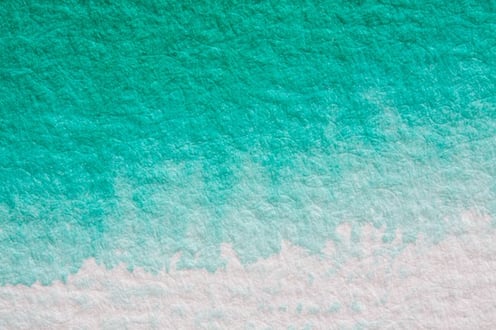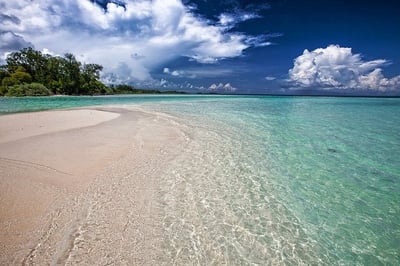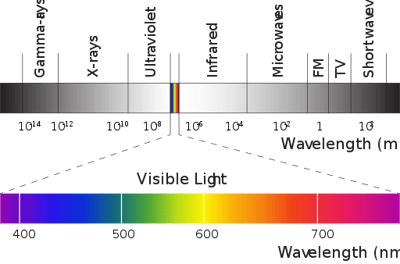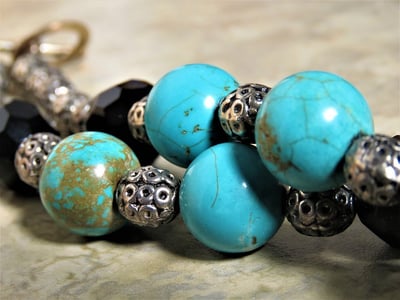What Paint Colors To Mix To Get Turquoise
Turquoise: information technology'due south a colour yous see brightening upward nature, fashion, and interior decorating. Simply where do you start if you want to create your own turquoise color? What colors make turquoise? With a bones understanding of color theory, you tin can produce a turquoise color for paintings and projects of your ain! This article will respond your questions nearly how to make turquoise and teach y'all how to make turquoise colors yourself. We'll give you lot: There's a lot to learn here, and so let's get going! Turquoise is made by mixing bluish and green. The amounts of each colour that y'all add to a mixture determine the shade of turquoise you will become. Turquoise falls between blueish and greenish on the color cycle, so shades of turquoise tin range from predominantly blue to predominantly green. You can experiment with the amounts of blue and dark-green you comprise in order to achieve different shades. As long as you're mixing bluish and light-green, you'll cease up with some variant of turquoise! But you probably know that there isn't just one shade of turquoise. There are many dissimilar shades of turquoise y'all can make! If yous desire to accomplish the right shade of turquoise, you need to have a basic understanding of the science of colour. By the end of the adjacent department, you lot'll sympathize how color works in order to create turquoise. If you lot're trying to mix the perfect turquoise colour for your embankment painting, so you'll need to empathize how color works from a scientific perspective. You might have learned in elementary school that blueish and green make turquoise. This is definitely true on a basic level! However, making the perfect turquoise color is a chip more complicated than just mixing bluish and green and hoping for the best. To answer the question, "What is turquoise," y'all demand to start with an agreement of how color works. Since color is created by light, we can look at how calorie-free interacts with objects to understand where color comes from. The experts on colour at Crayola describe how low-cal creates what we encounter as color like this: When light shines on an object some colors bounce off the object and others are absorbed by it. Our eyes merely see the colors that are bounced off or reflected. The sun's rays comprise all the colors of the rainbow mixed together. This mixture is known equally white light. When white light strikes a white crayon or marker butt, it appears white to u.s. considering it absorbs no colour and reflects all color equally. A black crayon or mark cap absorbs all colors equally and reflects none, so information technology looks blackness to the states. While artists consider black a colour, scientists do non considering black is the absenteeism of all color. So let'south break that downwards. In simpler terms, the physical makeup of an object makes information technology reflect light (besides called electromagnetic waves) in a new way, which makes color! Sometimes all color bounces off an object to make it appear white. A black object will reflect no colors, which makes information technology appear black. Most of the time, though, an object will reflect some light...which is why it has color! When an object appears to be blueish, green, or red to your eyes, you're seeing the wavelength of light that the object is reflecting. So what'due south a wavelength, anyway? Wavelengths of calorie-free tin can exist compared to the movements of water at the beach. The waves volition come in high and close together at certain times, only low and further apart at other times. Now, say yous decided to measure those waves. Yous'd first at the crest, or highest point of one wave, then mensurate to the crest of the adjacent wave. These measurements would give you the wavelength of the water striking the beach. The mode that light works is similar--merely waves of light are a lot smaller and closer together. When these lengths bounce off an object, your optics measure out them...and your encephalon translates them into colour. The "spectrum" refers to the full range of possible wavelengths of lite. The spectrum of lite tin can exist translated into the spectrum of colour like this: (MNDNF/Wikimedia) A single wavelength of light is measured using nanometers (nm). Longer wavelengths produce "warmer" colors, and shorter wavelengths brand "cooler" colors. You might have noticed that we're simply able to see a small portion of the entire spectrum of light. Our eyes can only meet those wavelengths between approximately 400 and 800 nanometers. Just the possible wavelengths of light span far beyond the boundaries of that small range! Certain animals, similar sockeye salmon and European roller bird chicks, tin can encounter much more of the spectrum than we tin can. The range of light that humans can see without the help of technology is called the "visible spectrum." Blue and green, the 2 colors that combine to make turquoise, appear on the visible spectrum. Blue has wavelengths between about 450 and 495 nanometers, and green has wavelengths between about 492 to 577 nanometers. An object our eyes perceive every bit turquoise has a makeup that causes it to absorb all wavelengths of low-cal except those that are between 450 and 577 nanometers in length. The object and then reflects those wavelengths of bluish and green back differently. The resulting mixture will make the object look turquoise to us! Cyan is a super of import color because it'south part of the color printing process. When y'all combine yellow, turquoise, cyan, and black in different combinations, yous can make all the colors of the rainbow. In the subtractive color model, which is used for color press, turquoise is considered a shade of the primary color cyan. Then yep: turquoise and cyan are the same color. Cyan appears between bluish and dark-green on the visible spectrum of light at effectually 490 to 520 nanometers. In some cases, cyan may exist considered synonymous with turquoise. Both colors are a very like brilliant, greenish-blueish. When you use blueish and green as your base colors, you take room to experiment with making turquoise in unlike ways. This process is a little complicated, but don't worry--we'll explain iii ways to use blue, green, and other colors to make turquoise side by side. What colors make turquoise? When you combine materials that reverberate light in different ways, their power to reflect lite is combined too. This combination occurs through two unlike methods: additive mixing and subtractive mixing. Additive mixing is a unproblematic way to create a new color past mixing different waves of light together. For instance, if you mixed a wavelength of 460 nanometers with some other, different wavelength of 540 nanometers, you would get turquoise. So what colors brand turquoise when wavelengths are combined? In additive mixing, blueish and green lite waves mix to make turquoise. Subtractive color mixing is a way to create new colors by removing wavelengths from the visible light spectrum through the use of paints, dyes, or pigments. This process is called subtractive mixing because when we mix colored paints or pigments, some wavelengths are absorbed. Each pigment or pigment being mixed absorbs some wavelengths and reflects others. This allows the states to dial in the wavelength of light that'due south reflected so that we get the perfect color! When it comes to combining pigments, mixing blueish and greenish is central to creating the color turquoise. Depending on the proportions you lot apply, you'll exist able to create different shades of turquoise! We mentioned earlier that there isn't just ane turquoise color. At that place are many unlike tints and shades of turquoise that y'all tin create! Before trying your hand at this, you need to know what tints and shades are beginning. Tints are more muted colors that are created when white is added to another color. Shades, on the other hand, are created past mixing black with another color to produce a darker color. The amount of black or white you add to another colour determines the saturation, or intensity, of the new colour you create. And then, for example, brighter colors won't take much white or black. When black and white are incorporated, the color wheel becomes a three dimensional color sphere. While turquoise can be fabricated using simply blue and green, you lot're only going to become more complex tints and shades of turquoise when y'all mix those colors with white or blackness! Now that y'all understand the scientific discipline behind making turquoise, you're probably catching on to the fact that yous tin can make dissimilar tints and shades of turquoise. By combining blue, green, and white in dissimilar ways and amounts, y'all can attain specific shades of turquoise. Keep reading to find out some of the virtually popular shades of turquoise! What colors make turquoise? Blue and green make turquoise, only you lot can add a higher ratio of blueish to dark-green to get a shade of turquoise blue. Adding in different amounts of white can help y'all achieve bluish turquoise shades that range from lighter to darker too! Tints of turquoise that would exist considered predominantly blue include: You already know that blue and green make turquoise with some white added in. Only you can amp up the corporeality of greenish in your mixture to achieve various tints of turquoise greenish. Here are seven shades of turquoise green that you tin can easily create: Turquoise colors can also be made by combining blue and green with pocket-sized amounts of greyness. Keep reading to find out about turquoise shades that can be created by combining blueish, dark-green, and gray. Turquoise originally referred to a mineral that's institute in nature. The mineral is an opaque, blueish greenish colour that comes from a hydrated phosphate of copper and aluminum. Effectively grades of turquoise are considered very valuable, especially as gemstones. Turquoise gemstones have been highly prized considering of their beautiful color. The give-and-take turquoise comes from the French word turquois, which means Turkish. This signifies how the mineral came to French republic: turquoise was brought to Europe by style of Turkey, from mines in a part of Iran once known every bit Persia. Before that, turquoise was mined in the Sinai Peninsula of ancient Arab republic of egypt. Turquoise prehistoric artifacts have besides been institute in Bulgaria, dating to the fifth millennium BCE. This means turquoise has been used, valued, and traded since antiquity. Turquoise is frequently used in jewelry, similar the turquoise beads in this bracelet. In the United states, turquoise is also associated with the southwest region, peculiarly Arizona and New Mexico. (That's by and large because it can exist found there!) The mineral was originally mined by pre-Columbian Native Americans using rock tools in the region. With its beautiful colour resembling the sea and the sky, turquoise came to symbolize powerful protection from harm. For case, the Aztecs incorporated turquoise into the design of ceremonial objects and weapons, and the Apache people believed that carrying a turquoise amulet could give an archer perfect aim. Thanks to these origins, people all over the world view turquoise equally a symbol of protection and promise today. People who aspect spiritual meaning to the turquoise color may view it equally the color of emotional residue. Turquoise is associated with open communication betwixt the head and the eye, which promotes calmness of spirit. Like many other gemstones, turquoise is too a birthstone. Turquoise is the birthstone for the month of December and is associated with the zodiac sign Sagittarius. For this birth month, turquoise is regarded as a symbol of good fortune and success. Real turquoise gemstones and jewelry are expensive and precious. But anyone with the correct art tools and understanding of color tin produce beautiful shades of turquoise for personal apply. We'll explain how you can make turquoise next! Learning all almost how to make turquoise probably has yous excited nearly creating your ain turquoise colors. To make turquoise, you lot need to have the correct colors on hand: blue, green, black, and white. Once you have your colors ready to go, keep reading for three tips to assistance y'all create your desired shades of turquoise. We also advise using the colour matching company Pantone's online colour tool to help you visualize the many possible shades of turquoise. Hue refers to the colored pigments that are visible to our eyes. And so hue refers to the chief and secondary colors ruby-red, orange, yellow, light-green, bluish, and violet, but non to mixed colors or white or black. Hue is strictly the element that produces the pure colour. Since turquoise falls on the spectrum betwixt blue and green, you can adjust the hues of blue and green you apply to attain the perfect shade of turquoise for y'all.. You can as well select blues and greens that range from cooler to warmer shades to achieve the specific shade of turquoise you want. Cooler shades of blue and green will produce a libation turquoise, whereas warmer shades of blue and green volition produce a warmer turquoise color. "Value" refers to the relative level of lightness or darkness of a colour. It'due south typical for colors with a lighter value (more than white added), like a light ocean light-green, to translate as lighter and calmer. You can probably match a light turquoise color in a painting you lot've seen by adjusting the value to comprise more than white. Yellow tin can too exist added in pocket-size amounts along with blue and green to attain a more subdued shade of turquoise. Darker values, which have more black added, tend to feel more ominous. You tin add black to darken turquoise, but it's far more than common to add darker shades of blue or green to reach a darker value. Midnight light-green and polished turquoise are two examples of darker turquoise shades that can be accomplished by adding darker dejection or greens. So if you want to go a darker, more vivid shade of turquoise, consider starting with a darker bluish or green base color. "Saturation" refers to the intensity of color in a hue in relation to the amount of white or black. When a color has smaller amounts of white or blackness added, it's more than saturated, or intense. If y'all want to go a bright turquoise or aquamarine, for example, you'll want to amp upwards the saturation. Less saturated colors will have larger amounts of white or black added. If you want a color with more saturation, add smaller amounts of white. Colors similar stake turquoise and icy teal accept a lower saturation, and pure turquoise and turquoise blue take a higher saturation. If you lot're an artist, then you may be interested in these 51 art scholarships that tin can help y'all pay for college. If you're serious nigh existence an artist, going to a top art school tin can assist launch your career. Bank check out this list of the 12 meridian international art schools to acquire more virtually the top art plan in the world. Many art programs require you lot to submit a portfolio of work equally part of the application process. This article will teach you lot everything you need to know about assembling a portfolio that catches reviewers' attending.
How To Make Turquoise: A Quick Primer 
What Is Turquoise? The Science Behind the Color

Is Turquoise the Same Color equally Cyan?
How Do Yous Make Turquoise?
How to Make Turquoise: Condiment Mixing
How to Make Turquoise: Subtractive Mixing
How to Make Turquoise: Tints and Shades
What Other Colors Can Y'all Make With Turquoise?
Predominantly Blue Tints of Turquoise
Turquoise Blue

Blue-Light-green

Celeste

Electric Blue

Ocean

Robin'south Egg

Midnight

Predominantly Green Tints of Turquoise
Turquoise Dark-green

Tiffany

Keppel

Light Cyan

Sea Green

Mist

Aquamarine

Turquoise With Gray Undertones
Teal

Rain

Catalina

Palladian Blue

Eucalyptus

Turquoise Color: Pregnant and History

3 Tips for Getting the Right Shade of Turquoise
Tip 1: Choose a Hue
Tip ii: Consider Darkness and Light
Tip 3: Adjust the Saturation

Now What?

Well-nigh the Author
Ashley Sufflé Robinson has a Ph.D. in 19th Century English Literature. As a content writer for PrepScholar, Ashley is passionate about giving college-jump students the in-depth information they need to get into the school of their dreams.
Source: https://blog.prepscholar.com/turquoise-color-blue-green-make
Posted by: morganyiestinne.blogspot.com

0 Response to "What Paint Colors To Mix To Get Turquoise"
Post a Comment